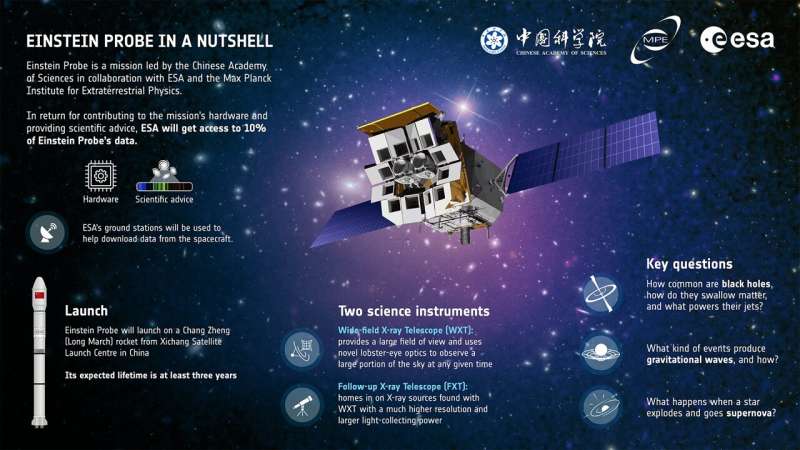Einstein detector.Image source: European Space Agency
The Chinese Academy of Sciences (CAS) Einstein probe spacecraft is ready for launch in January 2024. Equipped with a new generation of highly sensitive, wide-field X-ray instruments, the mission will survey the sky and look for powerful explosion shock waves. X-rays from mysterious objects such as neutron stars and black holes.
The Einstein probe is a project of CAS in collaboration with the European Space Agency (ESA) and the Max Planck Institute for Extraterrestrial Physics (MPE) in Germany.
In return for contributing to the development of the mission and the definition of its scientific objectives, ESA will receive 10% of the data generated by the Einstein probe’s observations.
“With its innovative design, the Einstein detector can monitor large swaths of the sky at a glance. In this way, we can discover many new sources while studying the behavior of X-rays from known objects over long periods of time,” said Erik Kulkers, ESA’s Einstein probe project scientist.
“The universe is our only laboratory for studying the most energetic processes. Missions like the Einstein Probe are critical to increasing our understanding of these processes and learning more about fundamental aspects of high-energy physics.”
Keep an eye on the X-ray sky
Unlike the stars that dot the sky at night and reliably mark constellations, most cosmic objects that glow in X-rays are highly variable. They constantly brighten and dim, and in many cases they appear briefly and then disappear for a long time (then called a transient) or disappear permanently.
Driven by turbulent cosmic events, X-rays from astronomical sources are extremely unpredictable. However, it carries fundamental information about some of the most mysterious objects and phenomena in our universe. X-rays are associated with collisions between neutron stars, supernova explosions, material falling into black holes or dense stars, or high-energy particles ejected from the disks of hot material surrounding these strange and mysterious objects.
The Einstein Detector will improve our understanding of these cosmic events by discovering new sources and monitoring changes in X-rays hitting objects in the sky.
The ability to regularly discover new X-ray sources is critical to improving our understanding of the origins of gravity waves. When two dense and massive objects, such as two neutron stars or black holes, collide, they create waves in the fabric of space-time that reach us across cosmic distances.
Several Earth probes can now record the signal, but often cannot locate the source. If neutron stars are involved, this “cosmic collision” is accompanied by a huge burst of energy across the entire spectrum, especially in X-rays. By allowing scientists to study these brief events in time, the Einstein detector will help us determine the origin of many of the gravitational wave pulses observed on Earth.
Lobster eyes in space
To achieve all its scientific goals, the Einstein Probe spacecraft is equipped with a new generation of instruments with high sensitivity and the ability to observe large areas of the sky: the Wide-field X-ray Telescope (WXT) and the follow-on telescope X-ray Telescope (FXT).
The WXT features an optical modular design that mimics a lobster eye and uses innovative microhole optical technology. This allows the instrument to observe 3,600 square degrees (nearly one-tenth of the celestial sphere) at once. Because of this unique ability, the Einstein probe can monitor nearly the entire night sky in three orbits around the Earth (each orbit takes 96 minutes).
WXT then discovers new X-ray sources or other interesting events, which are then located and studied in detail using the more sensitive FXT. Crucially, the spacecraft will also send warning signals to the ground to trigger other telescopes on Earth and in space operating at other wavelengths, from radio to gamma rays. They will quickly find new sources to collect valuable multi-wavelength data, allowing for a more thorough study of this event.
European contribution
ESA played an important role in developing the scientific instruments for the Einstein probe. It provides support for testing and calibrating WXT’s X-ray detectors and optics. ESA collaborated with MPE and Media Lario (Italy) to develop the mirror assembly for one of FXT’s two telescopes.
The FXT mirror assembly is based on the design and technology of ESA’s XMM-Newton mission and eROSITA X-ray telescope. MPE provided the mirror assembly for another of FXT’s telescopes and developed detector modules for two of FXT’s telescopes. ESA also provides systems for deflecting unwanted electrons away from the detector (electronic diverters).
Throughout the mission, ESA’s ground stations will be used to help download data from the spacecraft.
ESA’s high-energy mission fleet
ESA has a long history of promoting high-energy astronomy. For more than two decades, XMM-Newton and Integral have been studying the universe using X-rays and gamma rays, making tremendous progress in this area. ESA is also participating in the X-ray Imaging and Spectroscopy Mission (XRISM) led by the Japan Aerospace Exploration Agency (JAXA) in collaboration with NASA, launching in summer 2023.
“The capabilities of the Einstein detector are highly complementary to other missions’ in-depth study of single cosmic sources,” commented Eric. “This X-ray meter is also an ideal precursor to ESA’s NewAthena mission, which is currently underway. research and will become the largest X-ray observatory ever built.”
Provided by European Space Agency
citation: Innovative X-ray Lobster Eye mission to launch on December 21, 2023 (Retrieved December 22, 2023, from https://phys.org/news/2023-12-x-ray-lobster-eye-mission. html
This document is protected by copyright. No part may be reproduced without written permission except in the interests of fair dealing for private study or research purposes. Content is for reference only.
#Innovative #Xray #lobster #eye #mission #start
Image Source : phys.org
